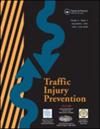Assessing bicycle helmet protection for head and neck in E-scooter falls
IF 1.9
3区 工程技术
Q3 PUBLIC, ENVIRONMENTAL & OCCUPATIONAL HEALTH
引用次数: 0
Abstract
Objectives
The rapid increase in E-scooter usage has led to more scooter-related head and neck injuries. Yet, experimental data on head impacts and helmet effectiveness during crashes are scarce. The objectives of this study are to experimentally evaluate bicycle helmets in E-scooter falls, assessing head kinematics, impact conditions, and injury risks in two crash scenarios with and without helmets.
Methods
Six E-scooter forward falls, induced by a curb collision at 20 km/h, were simulated in sled tests using a Hybrid III 50th anthropomorphic test device with and without a helmet. The curb was positioned either perpendicularly or at a 55° angle to the E-scooter’s trajectory. Head velocity, head acceleration, neck load, chest acceleration, and chest deflection were measured.
Results
The average normal and tangential head velocities at impact were 5.9 m/s and 3.7 m/s, respectively. In configurations without helmet, both head accelerations and neck loads exceeded some injury thresholds, indicating a risk of severe injury. Using a helmet significantly reduced peak head linear (143 g vs. 571 g) and rotational (9.8 krad/s2 vs. 23.1 krad/s2) accelerations, and Head Injury Criterion (HIC) (792 vs. 5868). However, it did not significantly affect peak head rotational velocity (44.5 rad/s vs. 41.5 rad/s), neck load (in flexion-compression) nor Neck Injury Criterion (NIJ) (1.2 vs. 1.0).
Conclusion
The bicycle helmet significantly reduced most head injury metrics. Yet, the risk of severe head and neck injuries remains high. These results offer valuable data for evaluating head protection and developing and validating numerical crash test reconstructions for further investigations.
电动滑板车摔倒时自行车头盔对头颈部保护的评估。
目的:快速增长的电动滑板车的使用已经导致更多的滑板车相关的头部和颈部损伤。然而,关于碰撞过程中头部撞击和头盔有效性的实验数据很少。本研究的目的是通过实验评估自行车头盔对电动滑板车摔倒的影响,评估头部运动学、冲击条件和两种碰撞场景下不戴头盔的伤害风险。方法:采用混合动力III 50型拟人试验装置,模拟了6辆电动滑板车在20 km/h的路缘碰撞下向前摔倒的情况。路缘要么垂直放置,要么与电动滑板车的轨迹成55°角。测量头部速度、头部加速度、颈部负荷、胸部加速度和胸部偏转。结果:撞击时的平均正切头速度为5.9 m/s,平均切头速度为3.7 m/s。在不戴头盔的情况下,头部加速度和颈部负荷都超过了一些损伤阈值,表明有严重损伤的风险。使用头盔可显著降低头部直线加速度(143 g vs. 571 g)和旋转加速度(9.8 kad /s2 vs. 23.1 kad /s2),以及头部损伤标准(HIC) (792 vs. 5868)。然而,它对峰值头部旋转速度(44.5 rad/s vs. 41.5 rad/s)、颈部负荷(屈曲-压缩)和颈部损伤标准(NIJ) (1.2 vs. 1.0)没有显著影响。结论:自行车头盔显著降低了大多数头部损伤指标。然而,头部和颈部严重受伤的风险仍然很高。这些结果为评估头部保护以及为进一步研究开发和验证数值碰撞测试重建提供了有价值的数据。
本文章由计算机程序翻译,如有差异,请以英文原文为准。
求助全文
约1分钟内获得全文
求助全文
来源期刊

Traffic Injury Prevention
PUBLIC, ENVIRONMENTAL & OCCUPATIONAL HEALTH-
CiteScore
3.60
自引率
10.00%
发文量
137
审稿时长
3 months
期刊介绍:
The purpose of Traffic Injury Prevention is to bridge the disciplines of medicine, engineering, public health and traffic safety in order to foster the science of traffic injury prevention. The archival journal focuses on research, interventions and evaluations within the areas of traffic safety, crash causation, injury prevention and treatment.
General topics within the journal''s scope are driver behavior, road infrastructure, emerging crash avoidance technologies, crash and injury epidemiology, alcohol and drugs, impact injury biomechanics, vehicle crashworthiness, occupant restraints, pedestrian safety, evaluation of interventions, economic consequences and emergency and clinical care with specific application to traffic injury prevention. The journal includes full length papers, review articles, case studies, brief technical notes and commentaries.
 求助内容:
求助内容: 应助结果提醒方式:
应助结果提醒方式:


